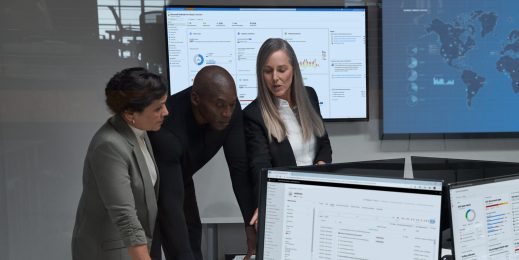
Uncertain Times Call for a Remote Work Enabled Future
As COVID-19 continues to disrupt businesses and communities around the world, I’ve been discussing with colleagues and customers on how we’ve all been coping. After hearing their stories, I have to say that I’m impressed by their strength and perseverance during these uncertain times. Many businesses and organizations have risen to the challenge.
The latest survey by Mercer (Business Responses to the COVID-19 Outbreak) found that close to 50 percent of all businesses are encouraging employees to work remotely, with 92.2 percent of companies making working from home their primary option during an office shut down. Jared Spataro, Microsoft 365 Corporate Vice President, recently shared this blog on learnings from working remotely during the #COVID19 outbreak.
At Microsoft, our main concern remains the safety and wellbeing of employees, and supporting customers whose businesses are being impacted. Since remote work is embedded in the modern workplace culture here, the immediate and negative impact to our business remains contained. It’s not uncommon to meet someone in the Taipei office who works and reports to a different group somewhere else. Take Rosie Tu for example; as the Commercial Surface Product Marketing Manager of the Greater China Surface Marketing Team, she is based in Taipei but works remotely with her teammates across the Greater China Region. Rosie has been managing a remote team in China for several years. Her remote work expertise is more relevant than ever now. Everyday she engages with five people on her team, plus 25 others spread between marketing, operations, finance, and cross functional departments. Rosie says the secret to achieving a remote working rhythm lies in trusting your team, sending frequent status updates, and using Teams for holding for one-on-one sessions.
“Trust is a two-way street. It creates positive feedback loops that further promote trust between teammates, coworkers and leaders — and this sets a foundation for effective remote teams and projects.”, she said.
Taiwan’s M365 Group Business Lead Flora Chen, recently shared with me that the APAC team she previously managed remotely was the one that she felt most connected to. That piqued my interest.
“We met in person once a quarter, or every six months. When we did get together in person, these were quality times and we made the most of them. We planned meaningful activities to make sure that we bonded and collaborated better. While working remote, we prioritized our one-on-one time on Teams to ensure frequent communication.”, Flora explained.
As the remote work trend shows no signs of slowing down, here are some best practice suggestions by Lily Zheng, a Microsoft colleague who lives and work in Shanghai, to help you navigate this work trend.
Stay well.
Working where you live while balancing family commitments can feel stressful. Taking time to exercise, eat well, and enjoy real downtime away from screens is essential to maintaining mental well-being while working from home.
Go all in.
It can be tempting to put things off while working remotely. But I’ve found teams that thrive remotely find ways to do just about everything online. If you’ve scheduled one-on-ones, keep them. If you’ve planned big meetings, hold them. If you’re ready to brainstorm an upcoming presentation, jump on a video call and use the digital whiteboard in Microsoft Teams.
Use video.
Experts estimate 55% of communication is nonverbal. So, when working remotely, I can’t recommend using video enough. I’ve personally found that turning on my video helps me connect with my colleagues in a way that’s hard to do if you’ve never met face-to-face, if even digitally. Microsoft Teams lets me blur my background if I’m in a distracting environment (like a messy kitchen) or turn on closed captions if I’m in a loud space and having a hard time hearing.
Immediately open the lines of communication.
When your employees are working remotely, it’s more important than ever to ensure everyone stays briefed on the business. One of our customers, a large Asia-based insurance company, started broadcasting video messages to their staff to make sure everyone had access to the latest information. With everyone balancing working from home with childcare and other challenges, recorded videos give people an opportunity to catch up when they can’t make a live meeting or briefing.
Support your teammates.
I’ve learned from this experience that supporting others is the best way to stay positive and energized. We use our online tools for more than just work, sharing photos of family and pets and checking in with each other throughout the day. Cheering each other up is not just good for maintaining morale, it also helps keep our team together when we work apart.
Even big meetings can be moved online.
Many of us are accustomed to quick calls or video chats with a few teammates, but large and formal meetings can also be successfully held online. With so many employees opting to work remotely, hospitals here in China have been gathering their staff remotely. One hospital in Dalian, for instance, has been holding large staff meetings via Microsoft Teams. Keys to successful online meetings include setting a clear agenda, practicing inclusion by resolving any audio issues at the start of the meeting, and taking clear notes to share as follow-ups later. Remember, too, that if your organization permits it, you can record meetings for those who can’t attend.
Tools like Teams and Surface PCs have become invaluable to our remote work practice. I’m grateful for technology that eliminates the physical distance between team members so we may carry on business as usual. At Microsoft we believe that innovative companies need to establish a collaborative working culture that allows employees to thrive, especially when remote work is a necessity due to a pandemic, natural disaster, or other dire situations. While remote work used to be a privilege, nowadays it’s a necessity. With the help of technology and fostering a diverse and inclusive culture, it can work for any business or organization.














